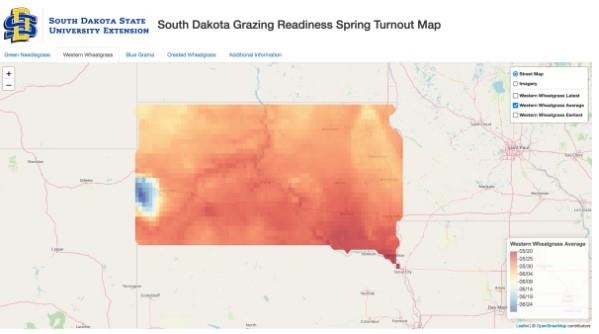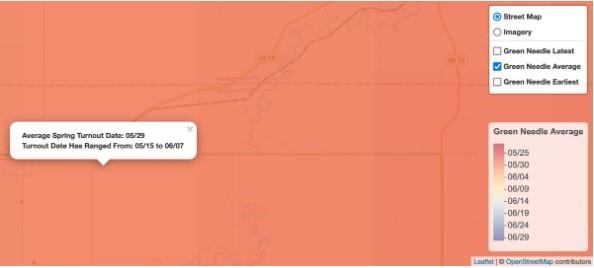
Figure 1. Map of average grazing readiness date for Western Wheatgrass in South Dakota. Note, for example, that the southeastern parts of the state reach grazing readiness for Western Wheatgrass earlier than the far northwest corner.
The South Dakota Grazing Readiness Map was developed to help livestock producers understand the earliest and range of spring turnout dates on their operation (Figure 1) and compare these dates between two native cool-season grasses (Green Needlegrass and Western Wheatgrass), a native warm-season grass (Blue Grama) and an introduced cool-season grass (Crested Wheatgrass).
LAUNCH TOOL
DATA SOURCE
Data for the grazing readiness tool was calculated using the PRISM 40-year dataset. Pixel size for each map is 4 km2. For each year and each pixel, the date which the cumulative GDD reached the required amount for grazing readiness was calculated for each species (Table 1). Base temperature for cool-season grasses is 32˚F and 40˚F for warm-season grasses. The average turnout date is the 40-year average day that enough GDD had accumulated for grazing. The required number of GDD for each species and the base temperature was based on previous work conducted at the U.S. Department of Agriculture (USDA) Agriculture Research Service at Mandan, North Dakota.
DATA SOURCE
Data for the grazing readiness tool was calculated using the PRISM 40-year dataset. Pixel size for each map is 4 km2. For each year and each pixel, the date which the cumulative GDD reached the required amount for grazing readiness was calculated for each species (Table 1).
Base temperature for cool-season grasses is 32˚F and 40˚F for warm-season grasses. The average turnout date is the 40-year average day that enough GDD had accumulated for grazing. The required number of GDD for each species and the base temperature was based on previous work conducted at the U.S. Department of Agriculture (USDA) Agriculture Research Service at Mandan, North Dakota.
Table 1. The number of cumulative growing degree days (GDD) for Haun Development Stage for four common species found in S.D.
| Grass | 3-Leaf Stage | 3.5-Leaf Stage |
|---|
| Crested Wheatgrass | 443 | 516 |
| Western Wheatgrass | 954 | 1,170 |
| Green Needlegrass | 1,037 | 1,209 |
| Blue Grama | 1,062 | 1,296 |

Figure 2. Close-up of the SDSU Cottonwood Field Station grazing readiness for Green Needlegrass. By clicking on a pixel location, users can display the latest, earliest and average spring turnout date based on the 40-year PRISM climate daily dataset.
TOOL USAGE
Users can select the grass species of interest using the tabs on top of the tool. Each map takes about 30 seconds to load and displays the latest, average and earliest spring turnout dates based on GDD for each 4 km2 pixel. Users can zoom into the map and toggle layers on and off for display. Upon clicking within a pixel on the map, a pop-up displaying the spring turnout dates for that grass species and pixel are displayed (Figure 2). This allows users to quickly identify the average spring turnout date for their location and the range of possible dates between species. The ‘Earliest’ is the earliest date over 40 years that enough GDD have accumulated for grazing. The ‘Latest’ is the latest date over 40 years that enough GDD have accumulated for grazing. For instance, the pop display of the South Dakota State University (SDSU) Cottonwood Field Station shows the average turn-out date for Green Needlegrass pastures was May 29, but has ranged from May 15 as the earliest date to June 7 at the latest date. Depending on the year and growing conditions, the expected turnout date can vary by a month.
"The key to utilizing this tool is outlining your management objectives and understanding the underlying species composition of pastures."
— Jameson Brennan, Assistant Professor/Research and Extension Specialist-Livestock Grazing
Conclusion
Overall, the South Dakota Grazing Readiness Map is one tool available to producers when they begin making plans for the grazing season. Additional factors producers might consider include management objectives. For example, producers may want to turn cattle out early in pastures to reduce cool-season invasive grasses. The key to utilizing this tool is outlining your management objectives and understanding the underlying species composition of pastures. Another way that producers can utilize this tool is to keep grazing records of when they turned into a pasture that was crested wheatgrass dominated or western wheatgrass dominated, etc. – by recording turn in dates every year, producers can begin to see trends on their individual operation and understand them in the greater context of the 40-year average, as presented by the South Dakota Grazing Readiness Map.
Source : sdstate.edu